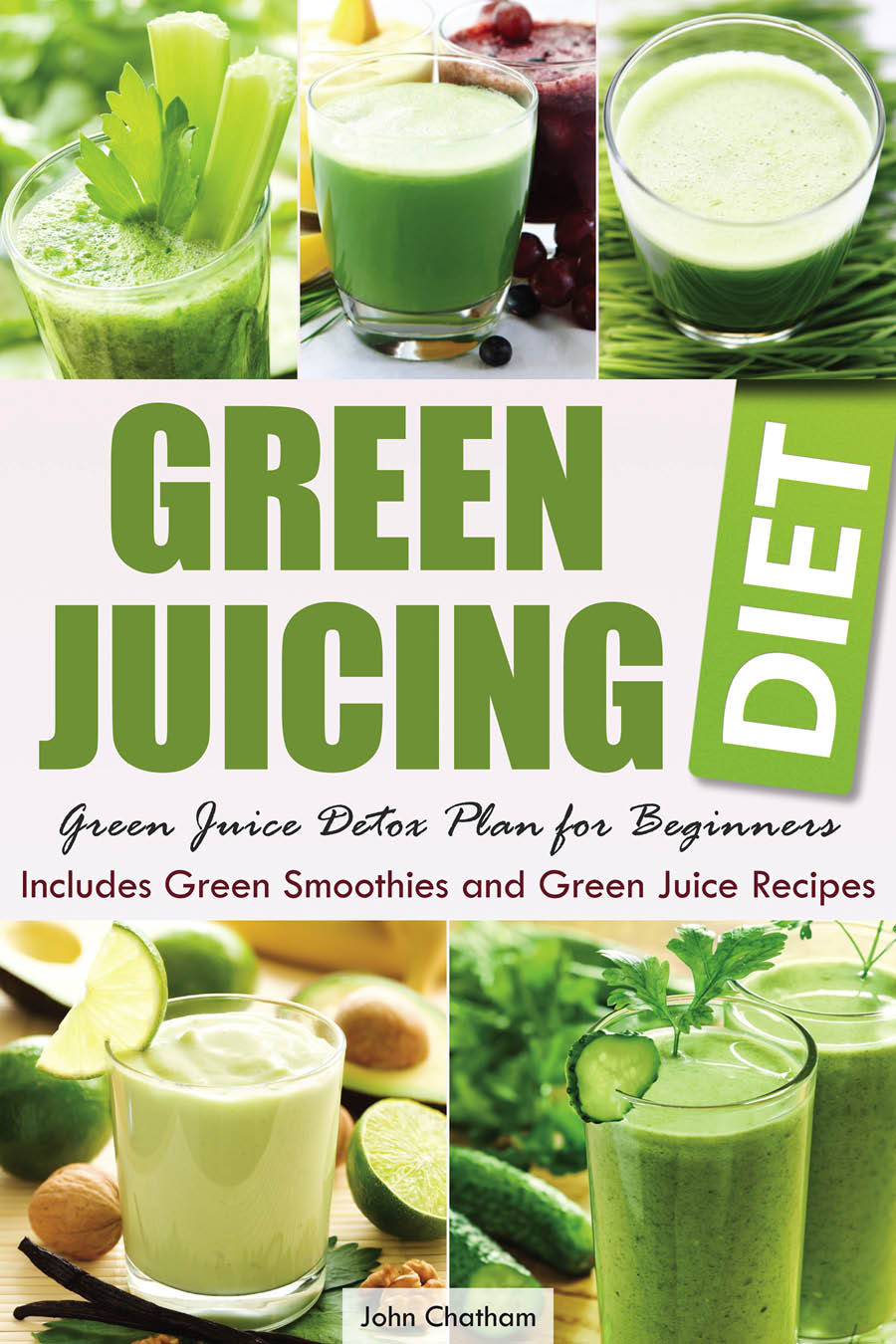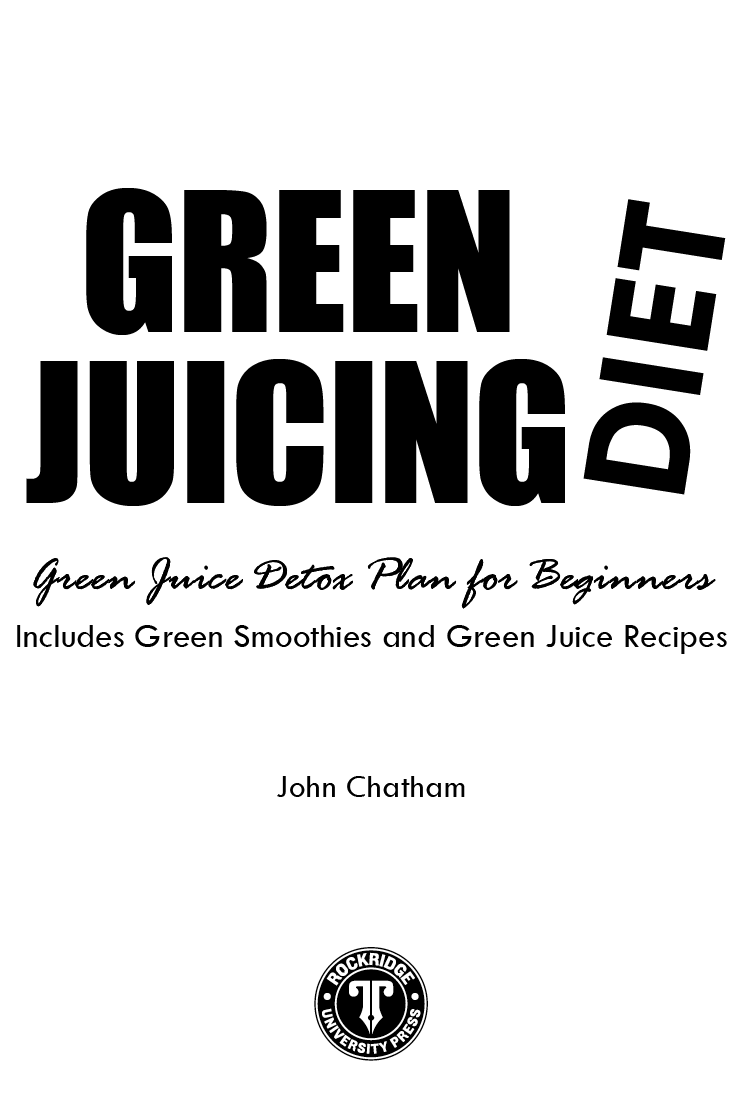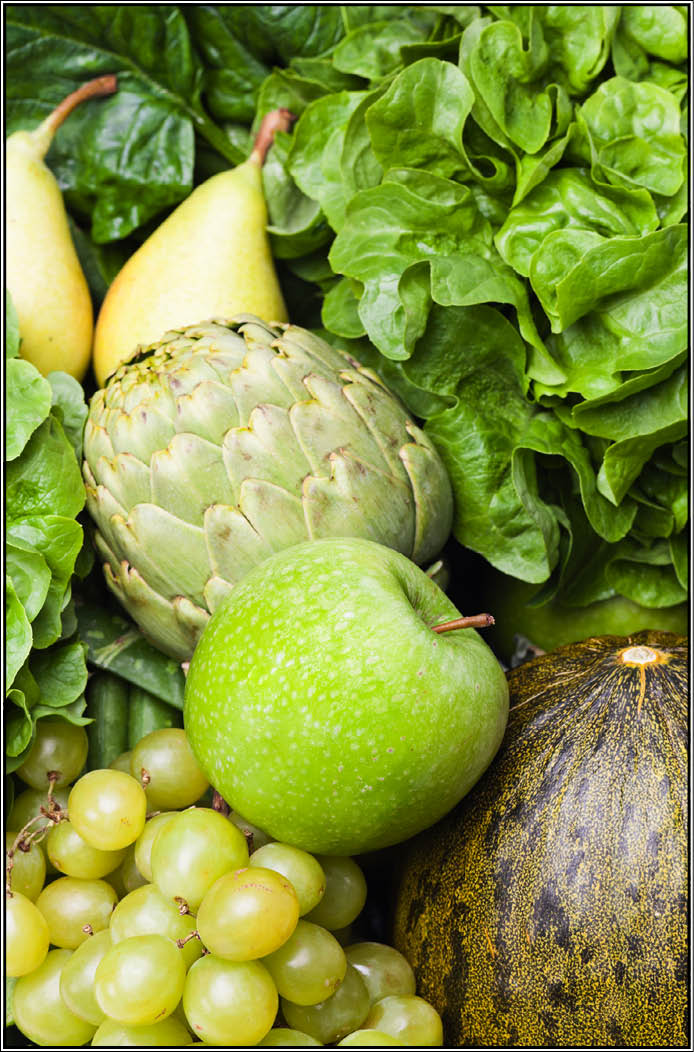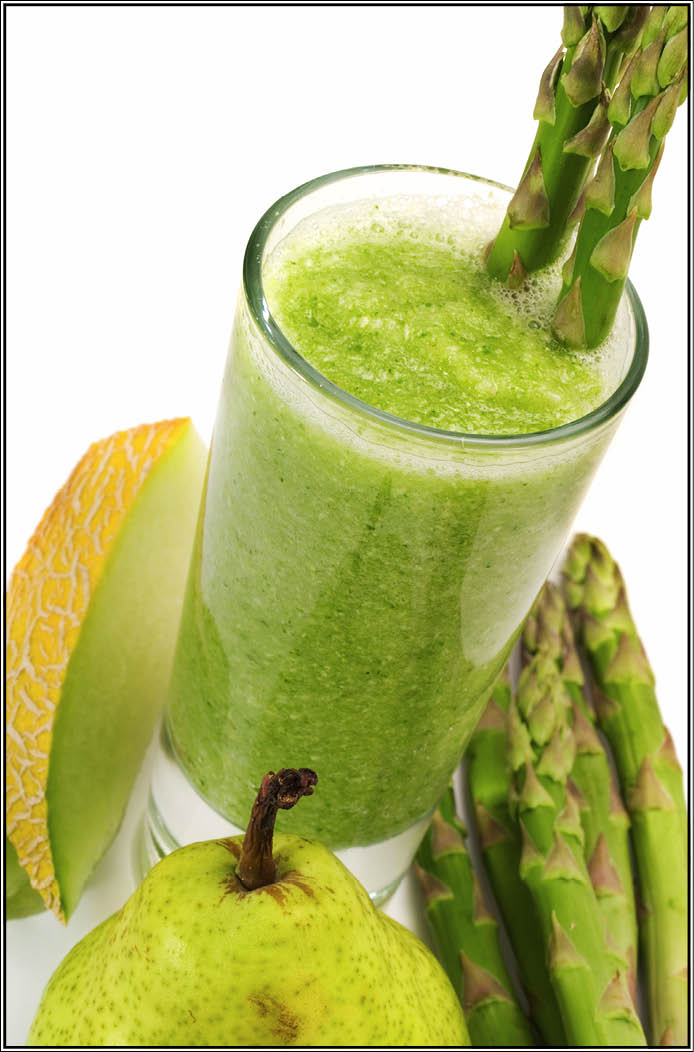Green Juicing Diet
Read Green Juicing Diet Online
Authors: John Chatham



Copyright © 2012 by Rockridge University Press, Berkeley, California
No part of this publication may be reproduced, stored in a retrieval system or transmitted in any form or by any means, electronic, mechanical, photocopying, recording, scanning or otherwise, except as permitted under Sections 107 or 108 of the 1976 United States Copyright Act, without the prior written permission of the Publisher. Requests to the Publisher for permission should be addressed to the Permissions Department, Rockridge University Press, 918 Parker St, Suite A-12, Berkeley, CA 94710.
Limit of Liability/Disclaimer of Warranty: The Publisher and the author make no representations or warranties with respect to the accuracy or completeness of the contents of this work and specifically disclaim all warranties, including without limitation warranties of fitness for a particular purpose. No warranty may be created or extended by sales or promotional materials. The advice and strategies contained herein may not be suitable for every situation. This work is sold with the understanding that the publisher is not engaged in rendering medical, legal or other professional advice or services. If professional assistance is required, the services of a competent professional person should be sought. Neither the Publisher nor the author shall be liable for damages arising herefrom. The fact that an individual, organization or website is referred to in this work as a citation and/or potential source of further information does not mean that the author or the Publisher endorses the information the individual, organization or website may provide or recommendations they/it may make. Further, readers should be aware that Internet websites listed in this work may have changed or disappeared between when this work was written and when it is read.
For general information on our other products and services or to obtain technical support, please contact our Customer Care Department within the U.S. at (866) 744-2665, or outside the U.S. at (510) 253-0500.
Rockridge University Press publishes its books in a variety of electronic and print formats. Some content that appears in print may not be available in electronic books, and vice versa.
TRADEMARKS: Rockridge University Press and the Rockridge University Press logo are trademarks or registered trademarks of Callisto Media Inc. and/or its affiliates, in the United States and other countries, and may not be used without written permission. All other trademarks are the property of their respective owners. Rockridge University Press is not associated with any product or vendor mentioned in this book.
ISBNs: Print 978-1-62315-054-9 | eBook 978-1-62315-055-6
TABLE OF CONTENTS
Chapter 1: To Green or Not to Green
Chapter 2: Going Green: The Basics
Chapter 3: Blender or Juicer: Picking the Perfect Machine for Your Needs
Chapter 4: What Are Those Green Goodies?
Chapter 5: What's the Big Deal about Juice Cleansing and Is It Right for You?
Chapter 6: Green Juice and Smoothie Recipes to Cure What Ails You!

INTRODUCTION
A
s we learn more about the functioning of the human body, we constantly strive to find better ways to keep it healthy and make it more efficient. Naturally, we want to be free of pain and disease in order to live our lives to the fullest. We also want to look good while we do this, and as we approach health from a more holistic point of view, we're learning that how we look and feel and how we perform are all intertwined. We're also learning that we get out of our bodies what we put into them. In other words, we really are what we eat.
Now that we understand that we have much more control over disease and aging than we once believed, we are significantly more selective about what we put into our bodies. We're decreasing our intake of bad fats and simple sugars and increasing our consumption of nutrient-rich vegetables and fruits. We're also becoming aware that not all cooking methods yield the same nutritional value.
Cooking often kills healthy enzymes and damages nutrients found in raw foods, so the search is on for better ways to eat raw. After all, sitting down and eating three apples, five leaves of kale, four carrots, and a raw beet takes time that most of us don't have. This is how we ended up eating fast food (gasp!) to begin with, so what's the answer? Juicing!
In just ten or fifteen minutes, you can toss your choice of fruits and vegetables into your juicer or blender and have an entire meal's worth of nutrients in a to-go glass. The only question is where to start. Juicing can seem like a daunting task, but throughout the following pages, you'll find all you need to know about the process, plus a collection of delicious recipes to put it into practice.
Why Go Green?
There are about a thousand varieties of vegetables and fruits that you could potentially add to your juice or smoothie, so what's the big deal about the green ones? In Chapter 1, we're going to discuss what it is about these emerald-colored bits of healthful deliciousness that make them the cream of the crop. We'll also touch on the technical and nutritional differences between juices and smoothies.
Going Green
In Chapter 2, we'll answer some of the top questions that beginning juicers and smoothie makers have about the process, ranging from technical questions about the physical method of juicing, to issues regarding nutrition and health, so stick around. Chances are pretty good you'll find all the answers you need. We'll also give you thirteen helpful tips to get started, including how to choose the right produce and how to store your juice in order to preserve the most nutrients.
Blending Versus Juicing
In Chapter 3, we'll go into a bit more detail about why you may choose juicing over blending or vice versa. We'll also discuss different types of blenders and juicers to give you a better idea of what to look for when you actually go shopping. There are literally dozens of different kinds on the market, and if you search blindly, chances are pretty good you'll end up unsatisfied with the machine you purchase.
The Goods on the Greens
In order to know what produce to choose, it's a good idea to understand what each one brings to the table. In Chapter 4, we'll take a close look at the nutritional value of the top fruits and vegetables. We'll also talk about the flavors of each so you'll know how to pair it with others. As a bonus, we've thrown in a quick reference page listing each fruit and vegetable that tells you approximately how much juice it will yield.
One of the common misconceptions about green juices or smoothies is that you can only use green vegetables. We're going to debunk this myth and reveal some tasty additions that will really add zest and personality to your drink. After all, just because it's healthy doesn't mean that it has to taste bland or unpleasant!
Cleansing and Fasting
Some people just want to add green juice or a smoothie to a healthy diet in order to reap the benefits of the extra nutrients. You may also choose to go on a green juice fast or undergo a green juice cleanse to detoxify your body and cleanse your digestive tract. This isn't a good idea for everyone, but it can be extremely beneficial under the right circumstances. In Chapter 5, we'll discuss this special subset of juicing to give you a better understanding of what this is, what to expect, and whether or not this may be something you want to do.
Getting Started in Juicing
Now that you know what green juicing is and why you should try it, we're going to get you started. In the final chapter of this book, you'll learn about how consuming juices or smoothies can help you surmount various health issues, and we'll provide some great-tasting recipes to get you going.
Ready?
So enough talk â let's get to it. Why should you go green? Read on and find out!


TO GREEN OR NOT TO GREEN
I
n today's health-conscious world, people are constantly looking for simple ways to eat a little healthier. Green juices and shakes are a great way to do that without sacrificing flavor or committing yourself to a restrictive diet. As a matter of fact, once you get the hang of it, you'll wonder why it took you so long to start juicing. This book will be your handy guide, and you'll be on your way in no time!
You may be thinking to yourself, “I can barely tolerate a few pieces of broccoli on my salad â now I'm thinking about drinking an
entire glass
of it?” Yes, you are, but don't look at it that way; if you do, you're already setting yourself up for failure. Think positively while we discuss what, exactly, green juicing is, and why you should give it a try.
What in the World Is Green Juicing?
Let's get your main misconception out of the way right out of the gate: Green juicing does
not
consist of drinking only green vegetables. You can make your juice that way if you prefer, but most people don't. Simply put, green juice is any juice (or smoothie) that is the color green. That's really all there is to it.
If you're sitting there drinking a glass of fresh green appleâgreen grapeâkiwi juice with a splash of OJ, it's green juice. Why? Because it's
green
! Your glass may contain a concoction that's clear and bright green, a deep, rich grassy green, or maybe even more Grinch-like in hue. Your fresh-squeezed glass of deliciousness may be a rainbow of colors, but as long as there's green somewhere in that rainbow, you're drinking green juice (or a green smoothie).
Smoothies, Juices: What's the Difference?
Juices and smoothies are two extremely different animals, and though both are amazingly good for you, each has its own benefits. So what's the difference between green juice and a green smoothie? In a word: pulp.
Juice is made in a juicer, or by blending the produce and extracting the juice via cheesecloth or some other method of straining. To make a smoothie, just throw your produce into the blender and blend it all together until it reaches a drinkable consistency. Juicing is a bit more of an art form than making a smoothie, but both have some basic rules you'll need to follow for optimal results. We'll touch on those throughout the following chapters.
So what's the nutritional difference between a smoothie and a juice? Again, the answer is in the pulp. A juice without pulp has practically no fiber, so the nutrients are absorbed almost instantly. This sounds like a good thing, and if your body is used to it, it is. However, if you're new to juicing, you may experience nausea, headaches, diarrhea, or dizziness, especially if you're juice fasting and not consuming any fiber at all.
Another issue to consider when you're deciding between juices or smoothies is that the heat caused by blenders and high-speed juicers may damage the nutrients in the produce and cause oxidation, killing the beneficial live enzymes. Whether to drink juices or smoothies is just a matter of personal choice and nutritional goals. We'll explore this topic in greater depth in Chapter 3.

Did You Know?
Within fifteen minutes of consumption, your body has absorbed about 95 percent of the nutrients in a glass of pure juice. Alternatively, it takes between five and eight hours for your body to extract and absorb most of the nutrients from solid food sources.

Green, Red, Orange, Purple: What's the Difference?
All fruits and vegetables are great for you, so what's the big deal about green juices in particular? The answer actually lies in the pigment that produces the green color: chlorophyll. Chlorophyll is often referred to as the blood of the plant and is responsible for stimulating the process known as photosynthesis. Simply stated, photosynthesis uses light to convert carbon dioxide and water into glucose, which is used for energy.
Structurally, chlorophyll is nearly identical to hemoglobin, the molecule in your blood responsible for transporting oxygen. The only difference is that the central atom of hemoglobin is iron, while that of chlorophyll is magnesium. Many people believe that chlorophyll performs the same function as hemoglobin and count this as one of its health benefits. Though not scientifically proven, it's a viable theory.
Chlorophyll also helps to replenish our red blood cells, which in turn increases oxygen levels in our blood. Other benefits often attributed to this amazing green pigment include how it:
⢠Promotes weight loss
⢠Protects DNA from damage by many carcinogens
⢠Enhances wound healing and tissue regeneration
⢠Increases energy
⢠Decreases inflammation in certain conditions, such as pancreatitis
⢠Decreases appetite because it contains the compound thylakoid
⢠Keeps carcinogens from attaching to DNA in many of your organs, and thus prevents development of cancer
⢠Helps break up calcium oxalate stones in your kidneys
⢠Extracts heavy metals, such as mercury, from your blood
⢠Stabilizes blood sugar
⢠Improves skin problems
⢠Improves mental clarity
⢠Maintains an alkaline environment in which diseases are unable to thrive
The reason it's better to consume chlorophyll from raw juices and smoothies rather than from cooked vegetables is that cooking lowers the chlorophyll content. You can tell when this happens because your vegetables will change from a bright green to a darker, olive green. Once they have changed to the darker hue, there is very little useful chlorophyll left in the produce.
Now that we've clarified the differences between juices and smoothies, and have reviewed the health benefits of green juices, let's move on to some of the other major juicing topics.
